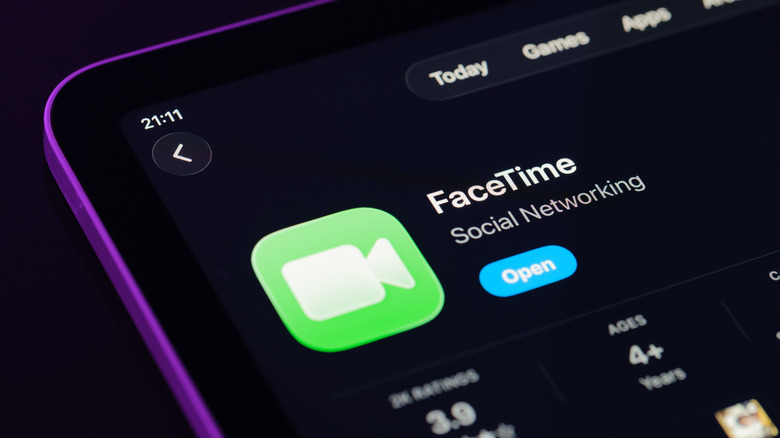Apple Got Rid Of A Major FaceTime Feature In iOS 26
Apple's newest mobile operating system, iOS 26, comes with all kinds of major design updates and an assortment of new Apple Intelligence-powered features — including some for FaceTime. However, it does so at the expense of one of the platform's most playful tools. While the rest of us have been trying to figure out if you can move the search bar back to the top, Apple quietly shook up its video calling. With this new update, FaceTime users can no longer use filters, stickers, text labels, or shapes during their calls.
In previous versions of iOS, FaceTime users could tap an "Effects" button during a call to swap their face with an animated Memoji, apply color-changing filters, or decorate the screen with stickers and captions. Sure, there's an argument to be made that these novelty features were completely frivolous, but they still gave FaceTime a more fun and casual edge (especially for families and younger users).
With iOS 26, we can confirm that the Effects menu has been removed from the FaceTime interface entirely. While Apple has not spoken on the decision to cut these features as of yet, they have dedicated plenty of space to explaining everything new with FaceTime.
iOS 26 brings fewer FaceTime effects and more useful features
The "Liquid Glass" revamp also brings with it a reimagined FaceTime. From the new interface to the greater privacy protections to the deeper integration with its artificial intelligence platform, FaceTime gives users plenty to play with — even if it doesn't include filters or stickers.
The app now launches to a card-style home screen that makes for a huge departure from the simple list of recent calls in iOS versions past. Each card shows the contact's photo, the details of the last call, and shortcuts to reconnect with them. If a contact has left a video message, that clip plays automatically as users scroll through their list. There's also a large green "New Call" button at the bottom of the screen.
Beyond this, the app also has a more modernized look with rounded menus and translucent buttons in line with the look and feel of iOS 26 as a whole. The same goes for actual FaceTime calls: In-call controls shrink down during conversations to avoid blocking the screen, and you can tap your video feed in the corner to see an expanded menu with options to toggle Portrait mode and Studio Light mode.
There are also two other buttons, a Memoji button and FaceTime Reactions, that are carried over from previous iOS versions. Make a heart, and a heart icon will appear. Make a thumbs-up, one will show on-screen. Play around with other common gestures to see what you can do.
New privacy features swap fun for functional
FaceTime also comes with Live Translation now. On supported Apple Intelligence devices running iOS 26, you can see live speech instantly transcribed and translated into another language during one-on-one calls. The feature only supports English, French, German, Portuguese (Brazil), and Spanish (Spain) for now, but more languages are expected to be added in the future.
Beyond this, Apple has also made FaceTime a safer and more controlled platform with the "Silence Unknown Callers" option and Communication Safety tools. Users can activate a "Sensitive Content Warning" that freezes a call and displays a safety notice if any nudity is detected. The feature relies on on-device machine learning, which means Apple itself does not receive or process the images.
It feels like Apple has used this new operating system as an excuse to make FaceTiming a much more dignified thing. Alas, if you're missing the filters, stickers, and text boxes, you might need to look to third-party video calling apps (or, if you're feeling brave, just uninstall iOS 26 altogether.)


